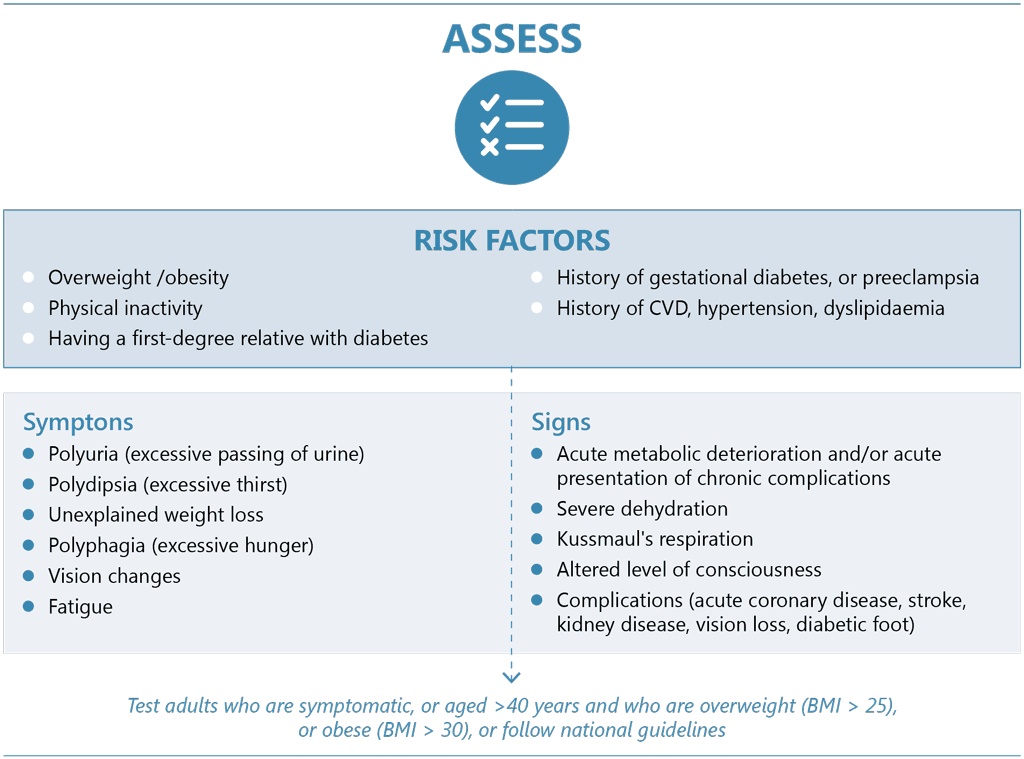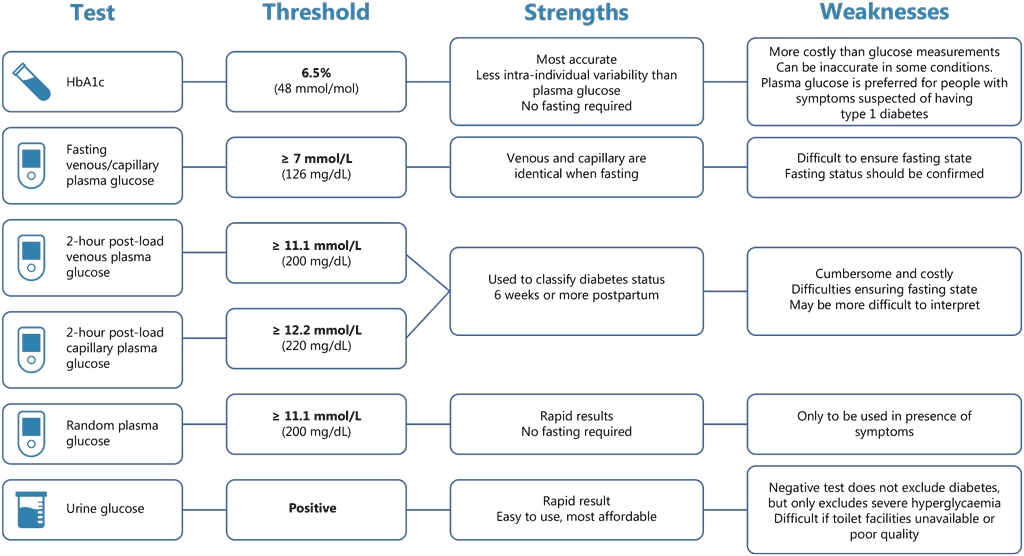Перекрёстные ссылки книги для 1266

WHO recommends biochemical testing for diabetes among adults who have signs and symptoms of diabetes, among adults who are ≥ 40 years with a BMI > 25 kg/m2 or anyone with a BMI > 30 kg/m2 (33,34). WHO also recommends that individuals with TB be screened for diabetes (21).
Therefore, as part of the basic clinical package of TB care and aligned with scaling up access to diabetes diagnostic and treatment services, diabetes screening should be offered to people with TB, without incurring additional costs to the person in need.
4.1.1 Diabetes screening strategies for people with TB
Studies of diabetes screening among people with TB have reported considerable variation in the yield of newly diagnosed diabetes, from < 5% (144–154) to > 20% (62,155–159), according to the algorithm used, the background prevalence of diabetes and the selection and age of the individuals with TB who were tested for diabetes. Studies in which prevalence rates of diabetes > 20% among people with TB were conducted in countries in the regions of the Americas, South-East Asia and the Eastern Mediterranean, probably reflecting the higher background prevalence of diabetes in the general population in those regions (62,155–163).
To introduce diabetes screening of people with TB, NTPs and NCD programmes should co-develop strategies to identify diabetes among people with TB according to the epidemiology, resources and other factors, such as the structure of the health system (e.g. strength of primary care).
Strategies for identifying diabetes among people with TB comprise a combination of the following:
- assessment of known diabetes status or a previous diabetes diagnosis;
- assessment of signs and symptoms of diabetes, as well as risk factors such as age and BMI, to inform any decision on diabetes testing; and
- diabetes testing with biochemical tests for all people with TB with or without signs or symptoms of diabetes.
As part of good clinical practice and during the initial clinical consultation, evaluation of people newly registered for TB treatment should include enquiry about any past diagnosis of diabetes and past or current treatment with glucose-lowering medication. The literature indicates that the specificity of self-reported diabetes is > 95%, although the sensitivity for prevalent diabetes is about 50%, as many people have undiagnosed diabetes (164,165). Significant gaps have been reported in the cascade of care for diabetes, from testing to treatment to achieving glycaemic control, and strategies for retention in diabetes care should be strengthened (166–168). Assessment of known diabetes status may therefore be an opportunity for re-engaging individuals in diabetes care.
Diabetes testing with biochemical tests should be available to people attending TB care who do not know their diabetes status. This is particularly important in settings with a high background prevalence of diabetes or where the prevalence of diabetes is higher among people with TB than in the general population. TB and NCD programmes should jointly plan and advocate for resources to test all people with TB for diabetes without incurring out-of-pocket costs. Where universal diabetes testing for people with TB is not yet available, signs and symptoms of diabetes should be assessed, and BMI should be evaluated in line with WHO guidance for the general population (see Fig. 2). Adults with TB who have symptoms of diabetes or are > 40 years and are overweight and those who are obese (according to BMI) should be prioritized for diabetes testing, while scaling up diabetes testing services for all people with TB.
Validated tools for scoring diabetes risk exist for the general population in various settings (169–171). While studies have been conducted to assess the accuracy of “risk scores” as a first step before offering diabetes testing to people with TB, there is currently no WHO-recommended risk assessment tool and therefore none that have been validated for people with TB. This is an area for operational research (154,172).
Fig. 2. Assessment of signs and symptoms before testing for diabetes

Source: WHO (34).
4.1.2 How to diagnose diabetes in people with TB
Diagnosis of diabetes is based on values for plasma glucose or HbA1c. Diagnostic cut-off values and the strengths and weaknesses of available testing technologies are presented in Fig. 3. All the diabetes testing technologies are available in point-of-care form, and efforts should be made to expand access to these technologies within health-care settings that provide TB care to reduce the need for people with TB to travel to another facility for diagnostic confirmation (see section 2.4.3).
If an individual with TB presents with signs or symptoms of diabetes, one diabetes diagnostic test is generally sufficient to establish a diagnosis. In the presence of symptoms, a random plasma glucose test, a single fasting plasma glucose test, a post-load plasma glucose test or an HbA1c test may be used for diagnosis. In settings where no other point-of-care tests or laboratory facilities are available for plasma glucose or glycated haemoglobin measurement, urine dipsticks may be used. Urine dipsticks are simple to use but have low sensitivity; therefore, a negative test result does not exclude diabetes. Type 1 diabetes is more likely to present with symptoms, and its onset typically occurs in children and young adults. Plasma glucose is the preferred diagnostic test for people with symptoms who are suspected of having type 1 diabetes (33).
To confirm a diagnosis of diabetes in asymptomatic people identified through screening with a biochemical test, a repeated test is required, preferably with the same test, as soon as practicable, on a subsequent day (33). In such situations, a fasting plasma glucose test, a post-load plasma glucose test or an HbA1c test may be used for both screening and diagnostic confirmation.
Fig. 3. Diagnostic thresholds and strengths and weaknesses of diabetes tests

It should be noted that glucose levels can be elevated at the time of TB diagnosis due to stress or TB infection-related hyperglycaemia (173–175). Infection-related hyperglycaemia tends to decrease during TB treatment (176–178). Nevertheless, diabetes management should be based on the level of glycaemia, regardless of whether the hyperglycaemia might be transient or not. The intensity of treatment (diet and physical activity, oral glucose-lowering medicine, insulin) will depend on glycaemic values. If the hyperglycaemia is in fact transient, the treatment may not be continued at later follow-up appointments, according to glycaemic values. It is therefore critical to reassess the glycaemic status after 1 month as part of standard diabetes management (33).
People with TB and newly diagnosed hyperglycaemia should be advised about the importance of reassessment of glycaemic status, and the TB care provider should ensure that testing is offered before TB treatment ends, either at the facility or through referral to a facility where diabetes care is provided.

 Обратная связь
Обратная связь